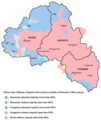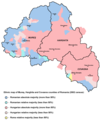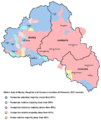| Revision as of 15:25, 29 May 2013 editKoertefa (talk | contribs)Extended confirmed users5,237 edits dubious and may not even be reliable: books from 1762, 1819 and 1889? These do not show the actual/current English usage; moreover, the last one just mentions their Latin name but uses the "Székely" version; there is no point of starting with this...← Previous edit | Revision as of 12:12, 30 May 2013 edit undo79.112.30.3 (talk) English and Hungarian books keep the old name Siculi.Next edit → | ||
| Line 12: | Line 12: | ||
| |related= ]}} | |related= ]}} | ||
| {{History of Hungary}} | {{History of Hungary}} | ||
| The '''Siculi''' <ref>A.F. Busching, (tr.P. Murdoch), A New System of Geography: Hungary, | |||
| ⚫ | The '''Székelys''' or '''Székely''' ({{IPA-hu|ˈseːkɛj}}), sometimes also referred to as '''Szeklers''' ({{lang-hu|Székelyek}}, {{lang-ro|Secui}}, {{lang-de|Szekler}}, {{lang-la|Siculi}}), are a subgroup of the ]<ref>{{cite book |title= Protestantism and politics in eastern Europe and Russia: the communist and postcommunist eras|last=Ramet |first=Sabrina P. |authorlink= |coauthors= |year=1992 |volume=3|publisher=] |location= |isbn=<!--0-8223-1241-7,--> 9780822312413|page=160 |pages= |url= http://books.google.com/books?id=O4GGgAmzl3gC&pg=PA160&lpg=PA160&dq=%22+subgroup+of+the+Hungarian+people%22&source=bl&ots=YhrN5qBKi3&sig=5-gfSElwcIlLXFyHWxDMmRd1SDI&hl=ro&ei=bkT9S9DMB4issAa3p9SfCA&sa=X&oi=book_result&ct=result&resnum=1&ved=0CBQQ6AEwAA#v=onepage&q=%22%20subgroup%20of%20the%20Hungarian%20people%22&f=false|accessdate=|quote=...the Szekler community, now regarded as a subgroup of the Hungarian people.}}</ref> living mostly in the ], an ethno-cultural region in eastern ], ].<ref name=Britannica/> A significant population descending from the ] lives in ] and ] counties in ] and in certain districts of ], ]. In 1952 the former province of Mureş (with the highest concentration of Székely population) was legally designated as the ]. It was superseded in 1960 by the Mureş Magyar Autonomous Region, itself divided in 1968 into three non-autonomous districts, Harghita, Covasna and Mureş.<ref name="Britannica"/> | ||
| Transylvania, Sclavonia, Publisher: General Books LLC ISBN-13: 9781150536472, | |||
| ⚫ | p. 75-78 </ref>,<ref>A. Rees, The cyclopædia, vol.36, (Chapter Transylvania), Ulan Press, 2012</ref>,<ref>W.H. Jones, L. Kropf, J.Kriza, The folk-tales of the Magyars, Publisher: Cornell University Library (January 6, 2010), ISBN-13: 978-1112602504</ref>, '''Székelys''' or '''Székely''' ({{IPA-hu|ˈseːkɛj}}), sometimes also referred to as '''Szeklers''' ({{lang-hu|Székelyek}}, {{lang-ro|Secui}}, {{lang-de|Szekler}}, {{lang-la|Siculi}}), are a subgroup of the ]<ref>{{cite book |title= Protestantism and politics in eastern Europe and Russia: the communist and postcommunist eras|last=Ramet |first=Sabrina P. |authorlink= |coauthors= |year=1992 |volume=3|publisher=] |location= |isbn=<!--0-8223-1241-7,--> 9780822312413|page=160 |pages= |url= http://books.google.com/books?id=O4GGgAmzl3gC&pg=PA160&lpg=PA160&dq=%22+subgroup+of+the+Hungarian+people%22&source=bl&ots=YhrN5qBKi3&sig=5-gfSElwcIlLXFyHWxDMmRd1SDI&hl=ro&ei=bkT9S9DMB4issAa3p9SfCA&sa=X&oi=book_result&ct=result&resnum=1&ved=0CBQQ6AEwAA#v=onepage&q=%22%20subgroup%20of%20the%20Hungarian%20people%22&f=false|accessdate=|quote=...the Szekler community, now regarded as a subgroup of the Hungarian people.}}</ref> living mostly in the ], an ethno-cultural region in eastern ], ].<ref name=Britannica/> A significant population descending from the ] lives in ] and ] counties in ] and in certain districts of ], ]. In 1952 the former province of Mureş (with the highest concentration of Székely population) was legally designated as the ]. It was superseded in 1960 by the Mureş Magyar Autonomous Region, itself divided in 1968 into three non-autonomous districts, Harghita, Covasna and Mureş.<ref name="Britannica"/> | ||
| In the ], the Székelys, along with the ], played a key role in the defense of the ] against the ]<ref name=ethnic>{{cite book|title=Ethnic Groups and Population Changes in Twentieth-century Central-Eastern Europe|author=Piotr Eberhardt|publisher=M. E. Sharpe, Armonk, NY and London, England, 2003|url=http://books.google.com/books?id=jLfX1q3kJzgC&printsec=frontcover&dq=Ethnic+Groups+and+Population+Changes+in+Twentieth-century+Central-Eastern#PRA1-PA334,M1 | isbn=978-0-7656-0665-5}}</ref> in their posture of guards of the eastern border. With the ] of 1920, Transylvania (including the Székely Land) became part of Romania, and the Székely population was a target of ] efforts.<ref>{{cite book |title=Whose Democracy?: Nationalism, Religion, and the Doctrine of Collective Rights in Post-1989 Eastern Europe |last=Ramet |first=Sabrina P. |year=1997 |publisher=] |location= |isbn=978-0-8476-8324-6 |pages=67–69 |chapter=The Hungarians of Transylvania }}</ref> In post-] Romania, where the Székelys form roughly a half of the ethnic Hungarian population, members of the group have been among the most vocal of Hungarians seeking an ] Hungarian region in Transylvania.<ref name=Columbia/> They were estimated to number about 860,000 in the 1970s and are officially recognized as a distinct minority group by the Romanian government.<ref name=Britannica/> | In the ], the Székelys, along with the ], played a key role in the defense of the ] against the ]<ref name=ethnic>{{cite book|title=Ethnic Groups and Population Changes in Twentieth-century Central-Eastern Europe|author=Piotr Eberhardt|publisher=M. E. Sharpe, Armonk, NY and London, England, 2003|url=http://books.google.com/books?id=jLfX1q3kJzgC&printsec=frontcover&dq=Ethnic+Groups+and+Population+Changes+in+Twentieth-century+Central-Eastern#PRA1-PA334,M1 | isbn=978-0-7656-0665-5}}</ref> in their posture of guards of the eastern border. With the ] of 1920, Transylvania (including the Székely Land) became part of Romania, and the Székely population was a target of ] efforts.<ref>{{cite book |title=Whose Democracy?: Nationalism, Religion, and the Doctrine of Collective Rights in Post-1989 Eastern Europe |last=Ramet |first=Sabrina P. |year=1997 |publisher=] |location= |isbn=978-0-8476-8324-6 |pages=67–69 |chapter=The Hungarians of Transylvania }}</ref> In post-] Romania, where the Székelys form roughly a half of the ethnic Hungarian population, members of the group have been among the most vocal of Hungarians seeking an ] Hungarian region in Transylvania.<ref name=Columbia/> They were estimated to number about 860,000 in the 1970s and are officially recognized as a distinct minority group by the Romanian government.<ref name=Britannica/> | ||
Revision as of 12:12, 30 May 2013
For other uses, see Székely (disambiguation). "Secui" redirects here. For the village in Dolj County, Romania, see Teasc. Ethnic group
| File:Szekelyek big.jpg1st row: Kelemen Mikes • György Dózsa • Sándor Kőrösi Csoma • Róza Laborfalvi 2nd row: Imre Mikó • Áron Gábor • Mózes Székely • Balázs Orbán 3rd row: Sámuel Teleki • Elek Benedek • Áron Márton • Áron Tamási 4th row: Pál Péter Domokos • Tivadar Puskás • Sándor Kányádi • • Sámuel Kálnoky | |
| Regions with significant populations | |
|---|---|
| Romania (mostly in the counties of Harghita, Covasna and parts of Mureş), southern Hungary and the rest of the world | |
| Languages | |
| Hungarian | |
| Religion | |
| Predominantly Roman Catholic, with Hungarian Reformed and Unitarian minorities | |
| Related ethnic groups | |
| Hungarians |
The Siculi ,,, Székelys or Székely (Hungarian pronunciation: [ˈseːkɛj]), sometimes also referred to as Szeklers (Template:Lang-hu, Template:Lang-ro, Template:Lang-de, Template:Lang-la), are a subgroup of the Hungarian people living mostly in the Székely Land, an ethno-cultural region in eastern Transylvania, Romania. A significant population descending from the Székelys of Bukovina lives in Tolna and Baranya counties in Hungary and in certain districts of Vojvodina, Serbia. In 1952 the former province of Mureş (with the highest concentration of Székely population) was legally designated as the Magyar Autonomous Region. It was superseded in 1960 by the Mureş Magyar Autonomous Region, itself divided in 1968 into three non-autonomous districts, Harghita, Covasna and Mureş.
In the Middle Ages, the Székelys, along with the Saxons, played a key role in the defense of the Kingdom of Hungary against the Ottomans in their posture of guards of the eastern border. With the Treaty of Trianon of 1920, Transylvania (including the Székely Land) became part of Romania, and the Székely population was a target of Romanianization efforts. In post-Cold War Romania, where the Székelys form roughly a half of the ethnic Hungarian population, members of the group have been among the most vocal of Hungarians seeking an autonomous Hungarian region in Transylvania. They were estimated to number about 860,000 in the 1970s and are officially recognized as a distinct minority group by the Romanian government.
Today's Székely Land roughly corresponds to the Romanian counties of Harghita, Covasna and central and eastern Mureş. Based on official 2011 Romanian census numbers, 1,237,276 ethnic Hungarians live in Romania, mostly in Transylvania. Of these, 611,391 (according to the 2011 Romanian Census) live in the counties of Harghita, Covasna and Mureş, which taken together have a Hungarian majority (58%). . The Hungarians in Székely Land therefore account for half (49.41%) of the Hungarians in Romania. When given the choice on the 2011 Romanian census between ethnically identifying as Székely or as Hungarian, the overwhelming majority of the Székelys chose the latter. Only 532 persons declared themselves as ethnic Székely.
History
Main article: History of the Székely peopleThe Székelys derive their name from a Hungarian expression meaning "frontier guards" and were regarded as the finest warriors of medieval Transylvania. The Székely territories came under the leadership of the Count of the Székelys (Latin: Comes Siculorum), initially a royal appointee from the non-Székely Hungarian nobility who was de facto a margrave; from the 15th century onward, the voivodes of Transylvania held the office themselves. The Székelys were considered a distinct ethnic group (natio Siculica) and formed part of the Unio Trium Nationum ("Union of Three Nations"), a coalition of three Transylvanian Estates, the other two "nations" being the (also predominantly Hungarian) nobility and the Saxon (that is, ethnic German) burghers. These three groups ruled Transylvania from 1438 onward, usually in harmony though sometimes in conflict with one another. During the Long War, the Székelys formed an alliance with Prince Michael the Brave of Wallachia against the army of Andrew Cardinal Báthory, recently appointed Prince of Transylvania.
Origins
The origin of the Székelys has been much debated. It is now generally accepted that they are descendants of Hungarians (or of Magyarized Turkic peoples) transplanted to the eastern Carpathians to guard the frontier, their name meaning simply "frontier guards". The Székelys have historically claimed descent from Attila's Huns (repeated in Procopius's De bello Gothico), and believed they played a special role in shaping Hungary. Ancient legends recount that a contingent of Huns remained in Transylvania, later allying with the main Hungarian army that conquered the Carpathian Basin in the 9th century. The thirteenth-century chronicler Simon of Kéza also claimed that the Székely people descended from Huns who lived in mountainous lands prior to the Hungarian conquest.
After the theory of Hunnic descent lost scholarly currency in the 20th century two substantial ideas emerged about Székely ancestry:
- Some scholars suggested that the Székelys were simply Magyars, like other Hungarians, transplanted in the Middle Ages to guard the frontiers. Researches could not prove that Szeklers spoke a different language. In this case, their strong cultural differences from other Hungarians stem from centuries of relative isolation in the mountains.
- Others suggested Turkic origin as Avar, Kabar or Esegel-Bulgar ancestries.
Some historians have dated the Székely presence in the Eastern Carpathians as early as the 5th century.
Their organization was historically of the Turkic type, and they are probably of at least partially Turkic stock. There is historical evidence that the Székelys were part of the Avar confederation during the so-called Dark Ages, but this does not mean that they were ethnically Avar. By the 11th century had adopted the Hungarian language.

Demographics
The Székely live mainly in Harghita, Covasna and Mureş counties. Hungarians form a majority of the population in the counties of Covasna and Harghita. From the late 20th century onward, many Székelys have migrated to Hungary, with smaller numbers establishing themselves in other European countries.
| County | Hungarians | % of county population |
|---|---|---|
| Harghita | 258,615 | 84.6% |
| Covasna | 164,158 | 73.8% |
| Mureş | 200,989 | 37.82% |
The relatively small and isolated Székely population on the border of Cluj County and Alba County (former Aranyosszék) assimilated more significantly during the 20th century than inhabitants of the more concentrated Székely areas. They are estimated to be less than 20,000 today. The Székelys of Bukovina, today settled mostly in Vojvodina and southern Hungary, form a culturally separate group with its own history.
Autonomy

There were Székely autonomous regions from 1952–1968. First the Magyar Autonomous Region was created in 1952, later (1960) renamed Mureş-Magyar Autonomous Region. Ever since the abolition of the Mureş-Magyar Autonomous Region by the Ceauşescu regime in 1968, some of the Székely have pressed for their autonomy to be restored. Several proposals have been discussed within the Székely Hungarian community and by the Romanian majority. One of the Székely autonomy initiatives is based on the model of the Spanish autonomous community of Catalonia. A major peaceful demonstration was held in 2006 in favor of autonomy.
-
 Ethnic map of Harghita, Covasna, and Mureş based on the 1992 data, showing areas with Hungarian (Székely) majority
Ethnic map of Harghita, Covasna, and Mureş based on the 1992 data, showing areas with Hungarian (Székely) majority
-
 Ethnic map of Harghita, Covasna, and Mureş based on the 2002 data, showing areas with Hungarian (Székely) majority
Ethnic map of Harghita, Covasna, and Mureş based on the 2002 data, showing areas with Hungarian (Székely) majority
-
 Ethnic map of Harghita, Covasna, and Mureş based on the 2011 data, showing areas with Hungarian (Székely) majority
Ethnic map of Harghita, Covasna, and Mureş based on the 2011 data, showing areas with Hungarian (Székely) majority
Literature
Áron Tamási, a 20th-century Székely writer from Lupeni, wrote many novels about the Székely which set universal stories of love and self-individuation against the backdrop of Székely village culture. Other well-known Székely writers include the folklorist Elek Benedek, the novelist József Nyírő, and the poet Sándor Kányádi.
Symbols


The Sun and Moon are the symbols of the Székely, and are used in the coat of arms of Transylvania and on the Romanian national coat of arms. The Sun and Moon symbols represented proto-Hungarian gods. After the Hungarians became Christians in the 11th century, the importance of these icons became purely visual and symbolic. Their original religious significance was lost. The Székelys have succeeded in preserving traditions to an extent unusual even in Central and Eastern Europe. The most comprehensive description of the Székely Land and its traditions was written between 1859–1868 by Balázs Orbán in his Description of the Székely Land.
Image gallery
- A Székely village in Covasna County, Romania A Székely village in Covasna County, Romania
-
 A "Székely gate"
A "Székely gate"
-
 Dârjiu fortified church is part of the UNESCO World Heritage
Dârjiu fortified church is part of the UNESCO World Heritage
-
Székely flag on the Houses of Parliament, Budapest, Hungary
See also
- Hungarians in Romania
- List of Székely settlements
- Székelys of Bukovina
- Székely Land (Székelyföld, Terra Siculorum, Ţinutul Secuiesc)
- Székely Himnusz
- Old Hungarian script (Székely runes)
- Szekler National Council
- Siculicidium
References
- Archivum Ottomanicum, Volume 20, Mouton, 2002, original from: the University of Michigan, p. 66, Cited: "A few tens of years ago the Szekler population was estimated at more than 800.000, but now they are probably ca. 500.000 in number."
- http://books.google.ro/books?id=jLfX1q3kJzgC&pg=PA334&dq=%22The+Szekely,+who+now+live+in+central+Romania,+are+estimated+to+number+some+500,000.%22&hl=ro&sa=X&ei=GUIIUcWPL8i20QXn4oG4AQ&redir_esc=y#v=onepage&q=%22The%20Szekely%2C%20who%20now%20live%20in%20central%20Romania%2C%20are%20estimated%20to%20number%20some%20500%2C000.%22&f=false
- Judit Tóth and Endre Sík, "Joining and EU: integration of Hungary or the Hungarians?" In: Willfried Spohn, Anna Triandafyllidou, Europeanisation, National Identities and Migration: Changes in Boundary Constructions between Western and Eastern Europe, Psychology Press, 2012, p. 228
- A.F. Busching, (tr.P. Murdoch), A New System of Geography: Hungary, Transylvania, Sclavonia, Publisher: General Books LLC ISBN-13: 9781150536472, p. 75-78
- A. Rees, The cyclopædia, vol.36, (Chapter Transylvania), Ulan Press, 2012
- W.H. Jones, L. Kropf, J.Kriza, The folk-tales of the Magyars, Publisher: Cornell University Library (January 6, 2010), ISBN-13: 978-1112602504
- Ramet, Sabrina P. (1992). Protestantism and politics in eastern Europe and Russia: the communist and postcommunist eras. Vol. 3. Duke University Press. p. 160. ISBN 9780822312413.
...the Szekler community, now regarded as a subgroup of the Hungarian people.
{{cite book}}: Cite has empty unknown parameter:|coauthors=(help) - ^ "Szekler people". Encyclopædia Britannica.
- Piotr Eberhardt. Ethnic Groups and Population Changes in Twentieth-century Central-Eastern Europe. M. E. Sharpe, Armonk, NY and London, England, 2003. ISBN 978-0-7656-0665-5.
- Ramet, Sabrina P. (1997). "The Hungarians of Transylvania". Whose Democracy?: Nationalism, Religion, and the Doctrine of Collective Rights in Post-1989 Eastern Europe. Rowman & Littlefield. pp. 67–69. ISBN 978-0-8476-8324-6.
- ^ "Székely". Columbia Encyclopedia. 2008. Retrieved 25 January 2009.
- Population census of 2011 Template:Ro icon – recensamant 2002 --> rezultate --> 4. POPULATIA DUPA ETNIE
- http://www.scribd.com/doc/86885327/CESCH-Recensamant-Populatie-2011-CV-Hr Document of the European Centre for Studies Covasna Harghita (NGO), page 28
- http://www.insse.ro/cms/files/RPL2002INS/vol4/notavol4.pdf
- http://mek.niif.hu/03400/03407/html/71.html
- Kevin Brook: Jews of Khazaria, Rowman & Littlefield Publisher, UK, 2006, page 170
- ^ Cathy O’Grady, Zoltán Kántor and Daniela Tarnovschi, Hungarians of Romania, In: Panayote Dimitras (editor) Center for Documentation and Information on Minorities in Europe — Southeast Europe (CEDIME-SE) MINORITIES IN SOUTHEAST EUROPE, Ethnocultural Diversity Resource Center, 2001, p. 5
- Template:Ro icon României îi este aplicabil modelul de autonomie al Cataloniei (The Catalan autonomy model is applicable in Romania), Gândul, 27 May 2006
- http://www.hunsor.se/avitus/szekelymanifest060316.htm
- http://www.sznt.ro/en/index.php?option=com_content&view=article&id=84&Itemid=21&lang=en
External links
- English
- Minority Cultures: The Szeklers Tortured History
- Ioan Aurel Pop, The Ethno-Confessional Structure of Medieval Transylvania and Hungary. Cluj Napoca, 1994 (bulletin of the Center for Transilvanian Studies, vol.III, nr.4, July 1994)
- Hungarian
- Romanian
| Ethnic groups in Romania | |
|---|---|
| Dominant group | Romanians (16,792,868) |
| Officially recognised minorities |
|
| Non-recognized minorities |
|
| Historical ethnic groups |
|
| Immigrant groups |
|
| |
| Hungarian diaspora | |
|---|---|
| Africa | |
| Europe | |
| Americas | |
| Oceania | |
| Peoples speaking Uralic languages | |
|---|---|
| Baltic Finns | |
| Sámi | |
| Volga Finns | |
| Permians | |
| Ob-Ugrians | |
| Hungarians | |
| Samoyeds | |
